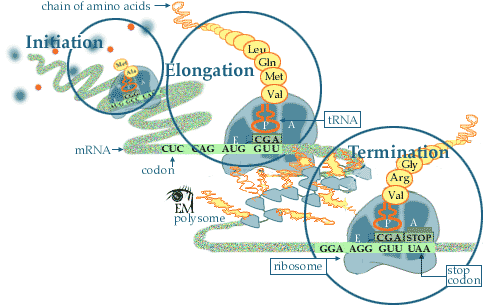Translation |
||

|
||
|
Translation is the actual
synthesis of a protein under the direction of mRNA.
During this process the
nucleotide sequence
of an mRNA (messenger RNA) is translated into the
amino acid sequence
of a protein. The protein synthesis requires a
technical machinery of high complexity. As compared
to information transfer between nucleic acid
molecules, where direct copying occurs on the basis
of base complementarity, the translation process
involves a greater number of chemical reactions and
the participation of additional nucleic acid and
protein components. One of these components, the
ribosome, provides the
basic machinery for the translation process. The
major role of the ribosome is to catalyse coupling of
amino acids into protein according to the sequence
specified by the mRNA. The amino acids are brought to
the ribosome by tRNA
(transfer RNA) molecules. Translation may be divided into three distinct steps. The first, initiation, results in the formation of an initiation complex in which the ribosome is bound to the specific initiation (start) site on the mRNA while the initiator tRNA is annealed to the initiator codon and bound to the ribosome. The second stage, elongation, consists of joining amino acids to the growing polypeptide chain according to the sequence specified by the message. Incorporation of each amino acid occurs by the same mechanism. Thus, the same steps are repeated over and over again until the termination codon is reached in the message. The termination codon gives the signal for the third and last stage of protein synthesis, the termination, in which the ready-made protein is released from the ribosome. |